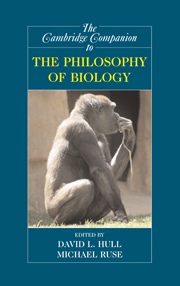Book contents
- Frontmatter
- 1 Adaptation
- 2 Population Genetics
- 3 Units and Levels of Selection
- 4 What’s Wrong with the Emergentist Statistical Interpretation of Natural Selection and Random Drift?
- 5 Gene
- 6 Information in Biology
- 7 Reductionism (and Antireductionism) in Biology
- 8 Mechanisms and Models
- 9 Teleology
- 10 Macroevolution, Minimalism, and the Radiation of the Animals
- 11 Philosophy and Phylogenetics: Historical and Current Connections
- 12 Human Evolution: The Three Grand Challenges of Human Biology
- 13 Varieties of Evolutionary Psychology
- 14 Neurobiology
- 15 Biological Explanations of Human Sexuality: The Genetic Basis of Sexual Orientation
- 16 Game Theory in Evolutionary Biology
- 17 What Is an ‘Embryo’ and How Do We Know?
- 18 Evolutionary Developmental Biology
- 19 Molecular and Systems Biology and Bioethics
- 20 Ecology
- 21 From Ecological Diversity to Biodiversity
- 22 Biology and Religion
- 23 The Moral Grammar of Narratives in History of Biology: The Case of Haeckel and Nazi Biology
- Reference List
- Index
- Series List
1 - Adaptation
Published online by Cambridge University Press: 28 April 2008
- Frontmatter
- 1 Adaptation
- 2 Population Genetics
- 3 Units and Levels of Selection
- 4 What’s Wrong with the Emergentist Statistical Interpretation of Natural Selection and Random Drift?
- 5 Gene
- 6 Information in Biology
- 7 Reductionism (and Antireductionism) in Biology
- 8 Mechanisms and Models
- 9 Teleology
- 10 Macroevolution, Minimalism, and the Radiation of the Animals
- 11 Philosophy and Phylogenetics: Historical and Current Connections
- 12 Human Evolution: The Three Grand Challenges of Human Biology
- 13 Varieties of Evolutionary Psychology
- 14 Neurobiology
- 15 Biological Explanations of Human Sexuality: The Genetic Basis of Sexual Orientation
- 16 Game Theory in Evolutionary Biology
- 17 What Is an ‘Embryo’ and How Do We Know?
- 18 Evolutionary Developmental Biology
- 19 Molecular and Systems Biology and Bioethics
- 20 Ecology
- 21 From Ecological Diversity to Biodiversity
- 22 Biology and Religion
- 23 The Moral Grammar of Narratives in History of Biology: The Case of Haeckel and Nazi Biology
- Reference List
- Index
- Series List
Summary
Eyes have long fascinated those who study the natural world. Cleanthes - the natural theologian protagonist of Hume's Dialogues Concerning Natural Religion - invites his interlocutor to 'consider, anatomize the eye: Survey its structure and contrivance; and tell me, from your own feeling, if the idea of a contriver does not immediately flow in upon you with a force like that of sensation' (1990, 65). Darwin, too, counted the eye among what he called 'organs of extreme perfection'. Placing himself squarely within the tradition that runs from natural theology, through Darwin, to a certain style of modern biology, Maynard Smith writes that 'the main task of any theory of evolution is to explain adaptive complexity, that is, to explain the same set of facts that Paley used as evidence of a creator' (1969, 82). More recently still, Dawkins (1986) is impressed, also, with a force like that of sensation, by how well suited - how well adapted, that is - the eye is to its purpose. Like Paley, he thinks eyes are better pieces of work than watches, although unlike Paley he regards their artificer as blind.
An essay on adaptation could fill volumes. One might begin by asking how adaptation is to be explained. Immediately we would need to answer the prior question of what the proper definition of adaptation is, and we would also have to get clear on the nature of the diverse candidate processes - natural selection, self-organisation, macromutation, development, divine design - sometimes tabled as potential explanations.
- Type
- Chapter
- Information
- The Cambridge Companion to the Philosophy of Biology , pp. 1 - 21Publisher: Cambridge University PressPrint publication year: 2007
- 3
- Cited by

